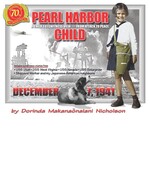
About the Author: Dorinda Nicholson
Dorinda Stagner Nicholson was born in Hawaii to a Hawaiian mother and Caucasian father. As civilians, Dorinda's family lived in Pearl Harbor. Standing in her front yard on December 7, 1941, she clung to her father's side while enemy torpedo bombers screamed overhead skimming the treetops. Her mother was a hula teacher, so Dorinda made her hula debut at the age of three. She graduated from Punahou School in Honolulu. While attending the University of Hawaii, she danced the hula on a weekly television show, Campus Canteen.
She won the KGMB-TV talent contest for hula performance, taking her to the mainland for the first time. She accepted a flight attendant job with a national airline before marrying Larry Nicholson, a professional photographer and multimedia producer.
After the birth of their four sons, she earned undergraduate, graduate, and postgraduate degrees in Counseling Psychology. She is a former adjunct college professor and currently a Marriage and Family therapist in a community mental health center. She authored a series of award-winning educational films on the history and culture of Hawaii and originated the concept for "A Woman's Year," the first national organizational calendar for women, published by Hallmark for more than fifteen years.
Her personal story remained untold until she wrote PEARL HARBOR CHILD, followed by the award-winning PEARL HARBOR WARRIORS. Her third book, REMEMBER WORLD WAR II, Kids Who Survived Tell Their Stories (National Geographic) captures not only WWII history, but the resilient and courageous stories seldom acknowledged or told—those of the children of war.
She is a National Speakers Association member and has been featured in People Magazine, BBC-TV, Asahi TV, NBC-TV, and on the History, Learning and Discovery Channels.

In commemoration of the 70th anniversary of the attacks on Pearl Harbor, award-winning author Dorinda Nicholson is releasing her book "Pearl Harbor Child" in ebook!
Years ago, I was told by a member of the Pearl Harbor Survivor's Association that I was too young to remember the attack, and I couldn't have been a civilian survivor of Pearl because, "there were no civilians, much less children, living inside the Harbor." He was wrong. I was there with my family, not on a burning ship, but close enough to see the burning ships anchored near our home.
Today, I still vividly remember watching the attack, I vividly remember the events, and I still remember his doubting comments. At first, I felt discounted and hurt by his skepticism. But now I am grateful. Grateful that it prompted me to ask lots of questions, do some research, and then write Pearl Harbor Child.
His doubting comment encouraged me to search for books, memoirs, and articles that might support the fact that civilians did indeed live in Pearl. When I couldn't find any, I began to doubt myself. The evidence that there was a neighborhood of civilians on the Pearl City Peninsula unexpectedly surfaced on a map taken from the dead body of a Japanese mini-submarine pilot. His map targeted the position of each ship in the harbor, and also detailed something else: the streets of our small civilian community on the peninsula, including Jean Street, where we lived and where I grew up.
December 7, 1941 is "a date that will live in infamy," according to President Roosevelt's famous speech. And for me, and thousands of others, it's true. Each year on that date, my thoughts always turn back to that incredible Sunday when bombs fell on Pearl Harbor.
 In commemoration of the 70th anniversary of the attacks on Pearl Harbor, award-winning author Dorinda Nicholson is releasing her book "Pearl Harbor Child" in ebook!
In commemoration of the 70th anniversary of the attacks on Pearl Harbor, award-winning author Dorinda Nicholson is releasing her book "Pearl Harbor Child" in ebook!